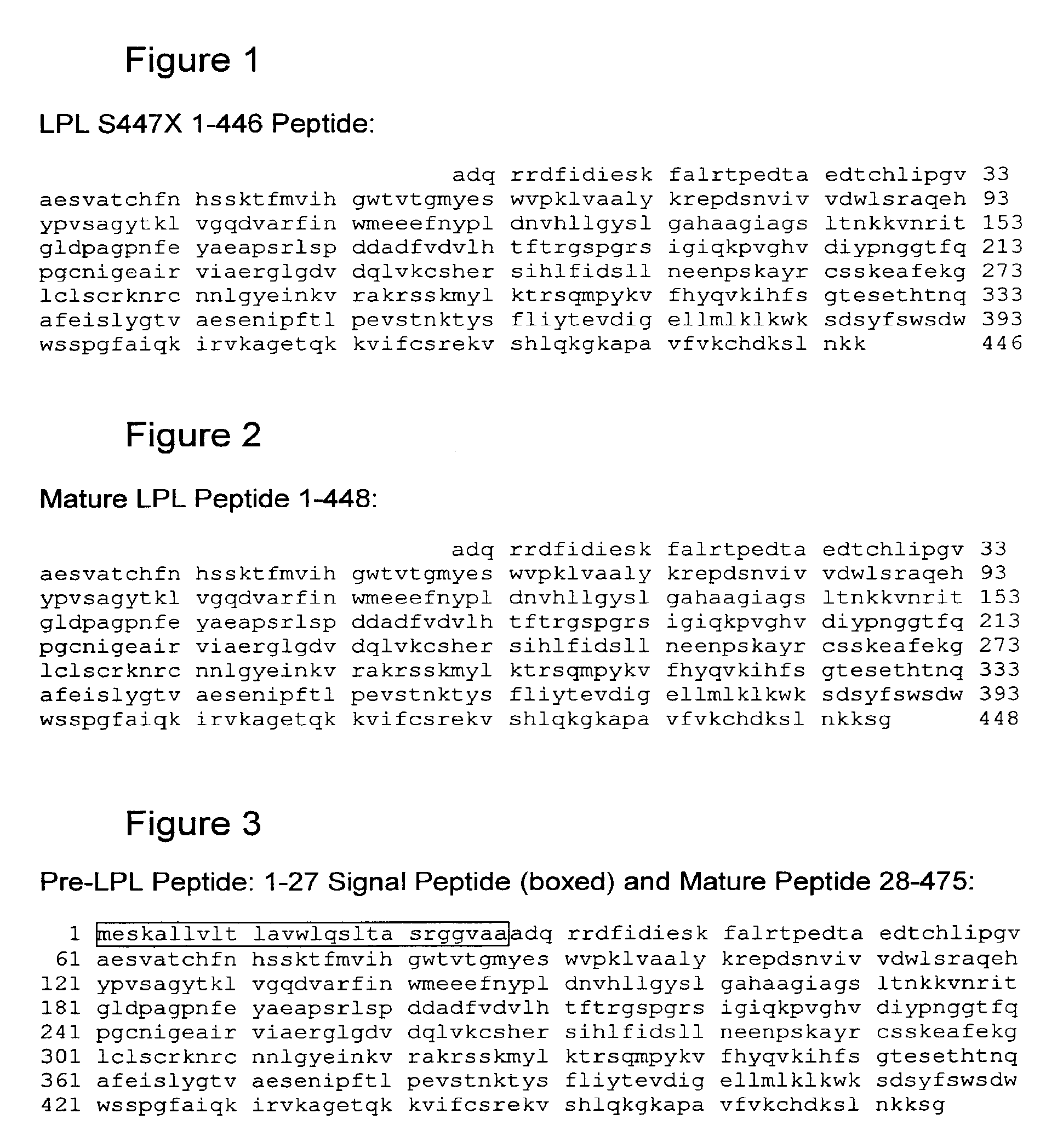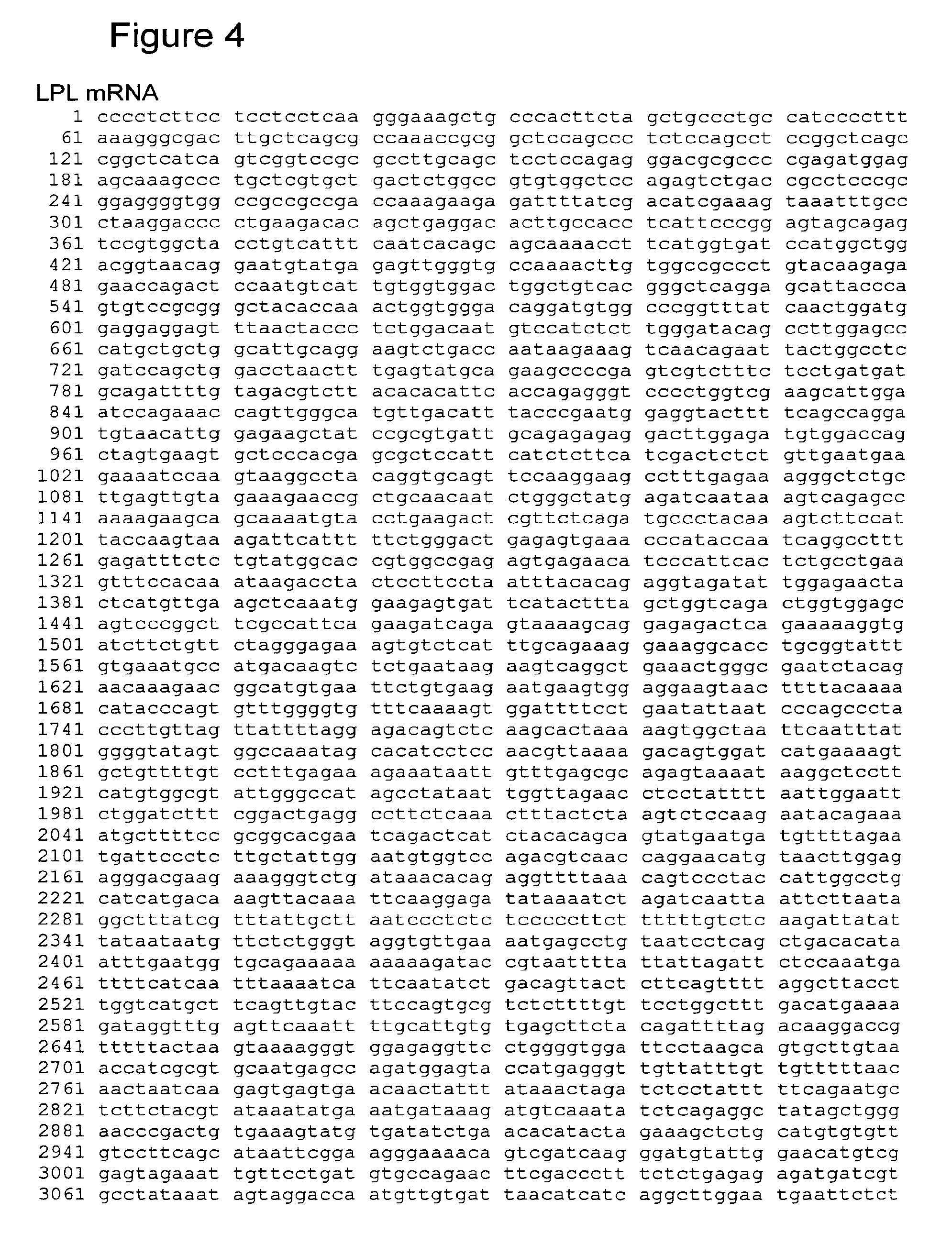LPL variant therapeutics
a lipoprotein lipase and variant technology, applied in the direction of viruses/bacteriophages, genetic material ingredients, dsdna viruses, etc., can solve the problems of prolonged post-prandial lipemia, ineffective lipid lowering drugs, and inability to tolerate rigid dietary restrictions
- Summary
- Abstract
- Description
- Claims
- Application Information
AI Technical Summary
Benefits of technology
Problems solved by technology
Method used
Image
Examples
example 1
[0069]Administration of LPL S447X Protein by Gene Therapy
[0070]A mouse model of human LPL deficiency has been created by gene-targeting to inactivate the murine LPL gene. All homozygous (− / −) pups die within 48 hours after birth with massive chylomicronemia from suckling milk. In attempt to rescue the − / − pups, intramuscular delivery of recombinant adenovirus containing the wild type human LPL gene (Ad-LPL) alone did not result in significant increase of human LPL mass in post-heparin plasma and did not rescue the lethality of complete LPL deficiency.
[0071]Intramuscular delivery of an Ad-447 gene therapy vector to newborn pups resulted in the appearance of human LPL mass in high levels in post-heparin plasma. In a litter of 4 pups, 2 were injected with Ad-447 (2×108 pfu in 100 μl PBS) to 4 sites (25 μl / site) in 4 limbs at the day of birth. Two days later heparin at 1000 u / kg was injected intraperitoneally and the pups were sacrificed by decapitation to collect about 10 to 20 μl post...
example 2
[0075]A serotype 5 adenovirus containing a LPL S447X gene under the control of the CMV-promoter was developed (Ad-447 as described in Example 1), and its effect compared to the effects of a wildtype LPL containing adenovirus. The animal model employed was the + / −LPL knock-out mouse model (Coleman et al., 1995, The Journal of Biological Chemistry 270[21], 12518-12525).
[0076]Preliminary in vitro studies done in HepG2 cells indicated a dose response relationship for LPL activity for the Ad-447 virus of a similar magnitude to the adenovirus containing the wild type LPL. There was, however, a marked difference in the amount of LPL immunoreactive mass. LPL immunoreactive mass in Ad-447 treated cells, at an MOI of 50 which infects essentially 100% of the cells, was roughly 4-fold greater that that of Ad-LPL.
[0077]When the dose response relationship of the Ad-447 virus was evaluated in a small cohort of mice via intravenous injection, unexpected results were obtained. The level of LPL activ...
example 3
[0079]This example illustrates that LPL mass and activity is associated with the severity of ischaemia and angina pectoris, indicating that the S447X therapeutics of the present invention may be used to treat such conditions by elevating LPL mass or activity.
[0080]In this example, post-heparin levels of LPL activity and mass were measured in a large cohort of male CHD patients participating in the REGRESS study, a lipid lowering regression trial (Jukema et al., 1995, Circulation 91: 2528-2540). In addition the relationships between LPL activity and mass and severity of angina pectoris according to the NYHA classification and silent ischaemia on 24 hour ambulatory (A)ECG monitoring were assessed. The results indicated that patients in different LPL activity quartiles and mass had different severity of angina; a total of 47% of patients in the lowest LPL quartile reported class 3 or 4 angina. By contrast, only 29% in the highest activity quartile (p=0.002) had severe angina. These par...
PUM
| Property | Measurement | Unit |
|---|---|---|
| pH | aaaaa | aaaaa |
| volume | aaaaa | aaaaa |
| density | aaaaa | aaaaa |
Abstract
Description
Claims
Application Information
 Login to View More
Login to View More - R&D
- Intellectual Property
- Life Sciences
- Materials
- Tech Scout
- Unparalleled Data Quality
- Higher Quality Content
- 60% Fewer Hallucinations
Browse by: Latest US Patents, China's latest patents, Technical Efficacy Thesaurus, Application Domain, Technology Topic, Popular Technical Reports.
© 2025 PatSnap. All rights reserved.Legal|Privacy policy|Modern Slavery Act Transparency Statement|Sitemap|About US| Contact US: help@patsnap.com



